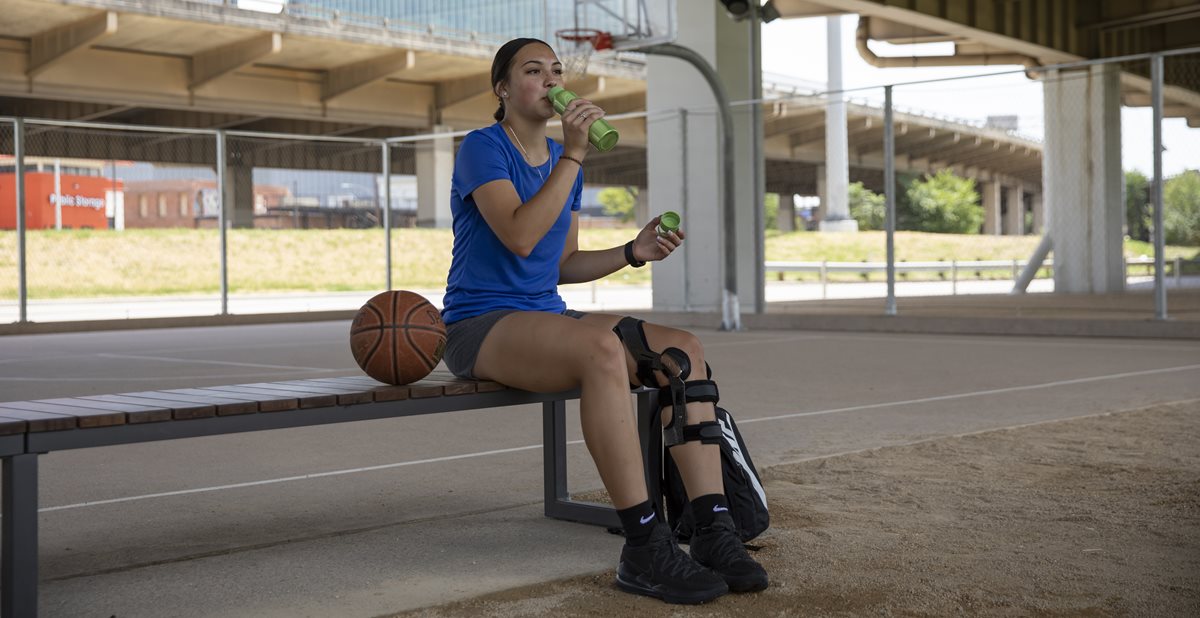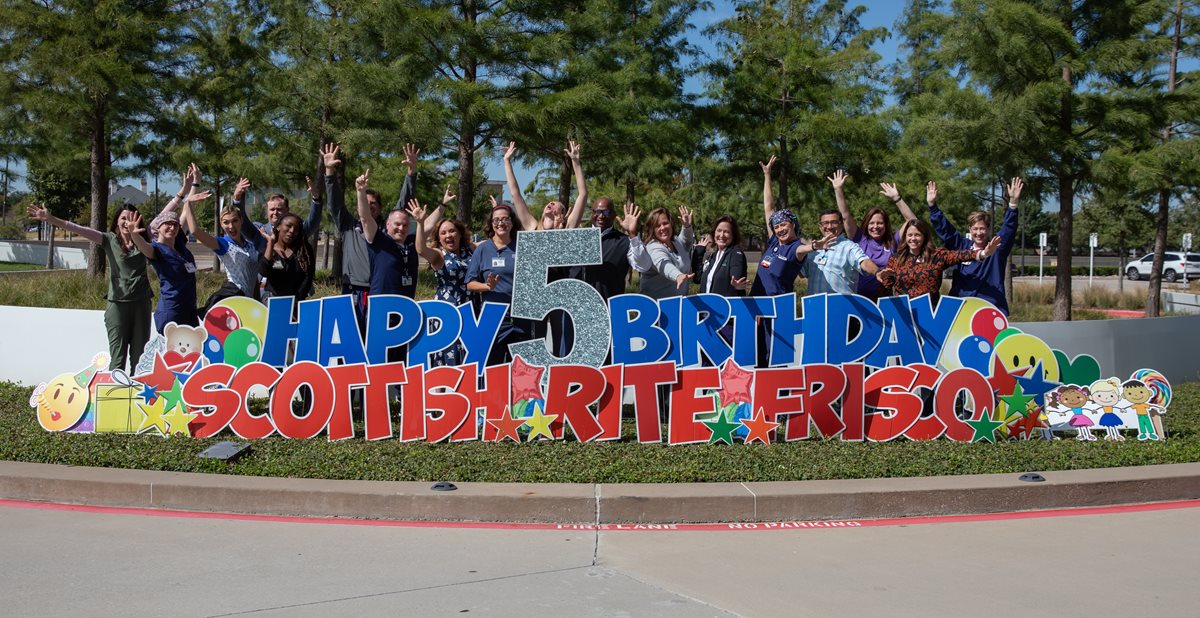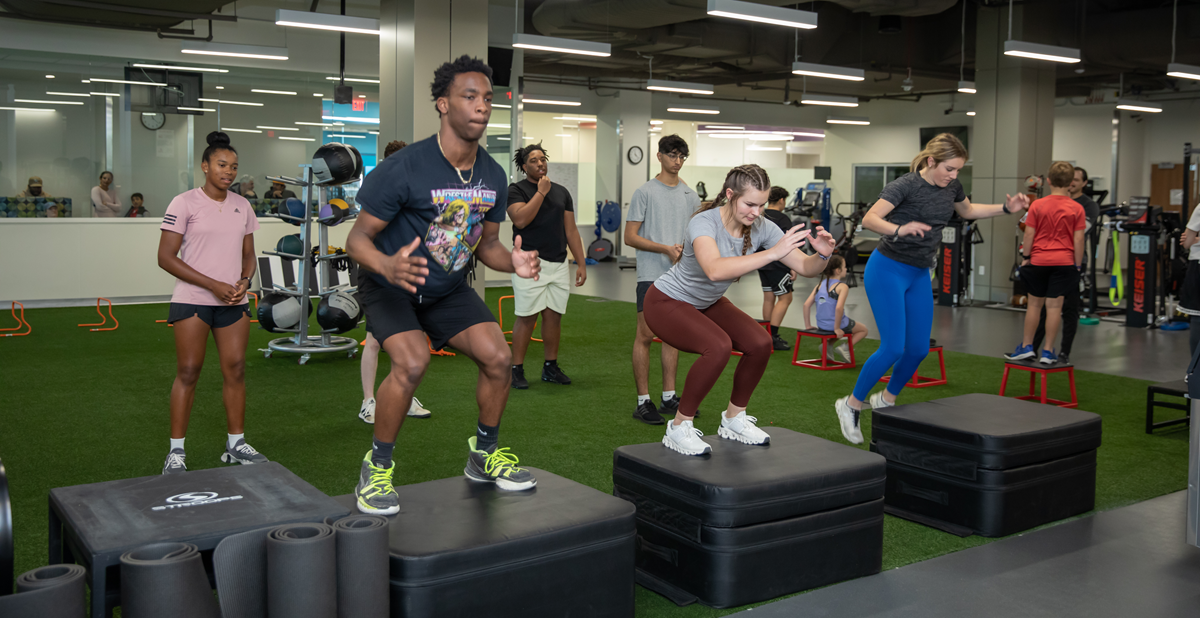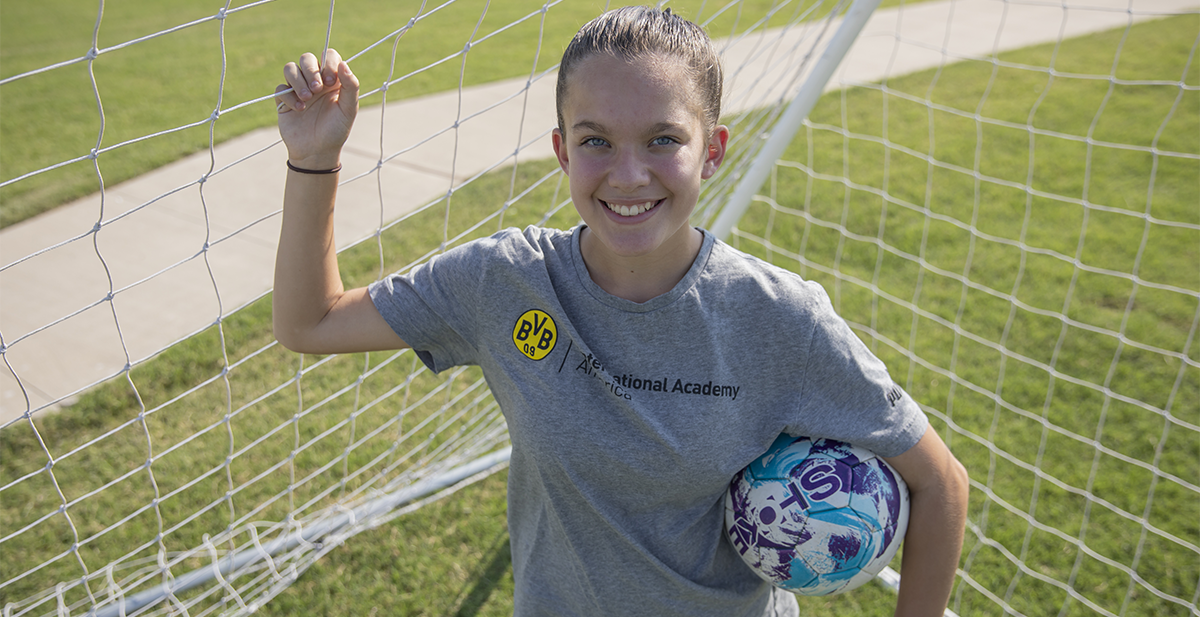
Nov 18, 2021 / Sports Medicine
The Comeback Kid
Cover story previously published in Rite Up, 2021 – Issue 3.
by Hayley Hair
On the wide-open field under the scorching summer sun, soccer player Lillian lines up her kick and launches the soccer ball through the air hurtling toward the goal. Today she’s in practice leading up to her select soccer team’s upcoming season. Last fall’s season looked dramatically different as an anterior cruciate ligament (ACL) rupture and meniscus tear took 12-year-old Lillian and her parents not only by surprise but also, unfortunately, out of the game.
“I was in the far corner and a girl hit me from the side,” Lillian says. “I heard several pops, and then I was on the ground in tears. It was just the most painful thing.” Lillian was able to limp away after the injury, but it hurt, and the pain persisted. Lillian’s mother, Debbie, set up a doctor’s appointment to have Lillian’s knee examined. “I had this vision that an ACL injury was excruciating, and you couldn’t walk,” Debbie says. “She was in pain, but not what I thought it would look like. It hurt, but she was mobile.”
Following X-rays and an MRI, Lillian’s injury was confirmed. “Just hearing the doctor say, ‘torn ACL,’ I couldn’t think of anything. My mind just stopped,” Lillian says. Later that day and feeling overwhelmed about her future sports goals, Lillian searched online to find out what professional athletes experienced injuries like hers. Then she saw her soccer idol’s name pop up on the list. “It’s happened to a lot of professional players, like Alex Morgan, who I’ve looked up to my entire life. That kind of comforted me.”
The ACL is a stabilizing ligament in the central part of the knee that stabilizes translation and rotation of the joint and is typically injured in pivoting, twisting and agility sports. Over the last several decades, recognition of ACL injuries has increased, and rupturing the ACL is particularly common in female soccer.
One hears about torn ACLs frequently in adult sports, but what happens when the injury presents in children? Lillian’s X-rays showed that her growth plates were still open, signaling plenty of growing in her future, so her best bet for care would be provided by a pediatric orthopedic specialist. She was referred to Scottish Rite for Children’s Orthopedics and Sports Medicine Center in Frisco and into the care of pediatric orthopedic surgeon Philip L. Wilson, M.D., assistant chief of staff and director of the Center for Excellence in Sports Medicine.
For a growing athlete, the experts at Scottish Rite for Children have unparalleled experience providing non-operative and arthroscopic care to treat common sport-related injuries including concussions, ligament injuries and cartilage conditions in the knee, ankle, shoulder, elbow and hip.
“Some ACL injuries may not need to be reconstructed if there are no cartilage injuries or shifting or instability of the knee,” Wilson says. “Unfortunately, this is less common, and despite rehabilitation, many children need surgery due to laxity in their ligaments and their high activity levels.” For Debbie and Sergio, Lillian’s parents, Wilson was the perfect fit for determining their daughter’s care.
“Dr. Wilson sat with me and my daughter and answered every question I had under the sun about the data, his experience and his research. He was an open book about everything,” Debbie says. “The whole team was positive. They made us feel like we had a great plan in place and that it’s all going to be just fine.”
That research Wilson reviewed with the family is the novel ACL surgical technique for growing athletes that he and pediatric orthopedic surgeon Henry B. Ellis, M.D., created and subsequently published in the American Journal of Sports Medicine and presented at the annual meetings of the Pediatric Orthopedic Society of North America and the American Orthopedic Society of Sports Medicine.
“We have found in our research at Scottish Rite studying a particular technique that we developed that this can cut ACL reinjury rates in half,” Wilson says. “Female adolescent soccer players, like Lillian, have a particularly high risk of reinjury, sometimes as high as 25%, which is the highest that we have recorded in youth and young adult sports. Adding the stabilizing ligament helps reduce that reinjury risk. She also had cartilage repair, which is common is 70% in our ACL injury population.”
Lillian had a quadriceps tendon autograft for her ACL repair. She also had a lateral tenodesis with her iliotibial band, which means Wilson used a strip of tissue from the side of the knee to add a secondary stabilizing ligament that helps control rotation and protect the knee.
“There’s nothing you can tell a parent to put them at ease when their child is going through the actual procedure,” Sergio says. “There’s nothing routine when someone puts your child under anesthesia, but when you are in a facility like Scottish Rite, in a place where the doctors are proven performers, that gives you peace of mind.”
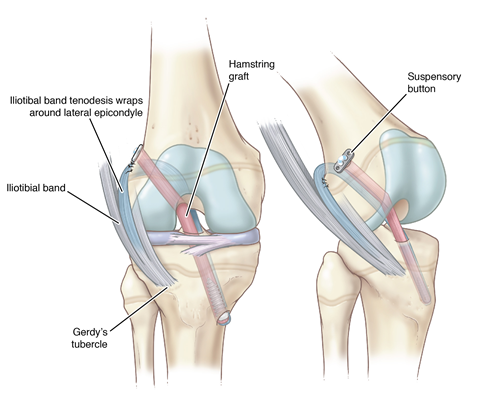
Scottish Rite provides world-class care for patients including access to psychologists, nutritionists, physical therapists, athletic training staff, specialized nurses, advanced practice providers and many others who play a significant role in ensuring complete physical and mental readiness to return to play. “We are fortunate to have the resources to take care of the whole patient,” Wilson says. “We also have a keen interest in the research surrounding these injuries and contribute to that research in terms of factors predictive of injury, surgery techniques, patient outcomes and potential complications of treatment.”
Finding the proper treatment and completing the surgery are a huge jump start to recovering from an ACL injury, but getting back on the field and ready to safely return to competitive game play takes time. For Lillian, it was nine months.
“When you see your child be very physically active, and then one day, it all comes crashing down, that for me as a parent was deeply concerning,” Debbie says. “I knew the journey to get anywhere near that level of activity again was going to be many, many months.”
By helping Lillian understand that recovery could take up to a year, Wilson worked alongside the family to get her healthy both physically and mentally to return to soccer. “Every time I went to visit him, he said I was doing great and healing ahead of schedule, and that made me want to work even harder,” Lillian says. “I pushed my hardest through every single drill and activity I did, and here I am, and I feel better than ever.”
Wilson says the biology of internal healing in the knee takes at least nine months. That time allows for the new ligament graft to heal to the bone and grow a blood supply. That also includes building back the muscle and strength to regain control of the leg to protect the surgically constructed knee. “Return prior to that time leads to increased reinjury rates,” Wilson says. “Scottish Rite has a stepwise progression of strengthening, agility and neuromuscular control activities to help prepare patients to return to sports.”
Following Scottish Rite’s well-established, highly successful physical therapy program, Wilson recommended Lillian participate in Scottish Rite’s training classes to foster further recovery and prepare for the functional testing and physician’s clearance required for her to safely return to soccer. Following months of rehabilitation, many patients need additional strengthening and emotional support to trust their injured leg, beyond what can typically be received during traditional physical therapy. “I just felt so much comfort even though I didn’t know anyone there,” Lillian says. “Being around the people who have had an injury and who are around my age, it just felt so heartwarming. We would help each other no matter what, and it was just an amazing feeling.”
Lillian followed her sports medicine team’s instructions very closely. With a great deal of hard work, and added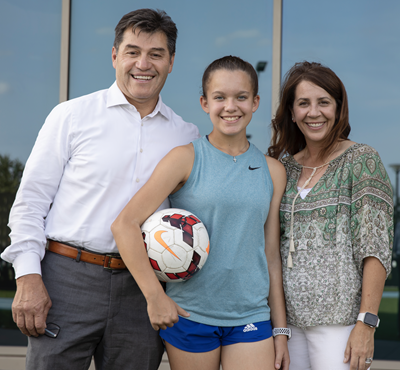 support and encouragement from her parents and her teammates, she successfully passed her functional test.
support and encouragement from her parents and her teammates, she successfully passed her functional test.
The new soccer season has arrived, and Lillian’s parents love seeing her back out there. “Whenever you have to see them take their first tumble to the ground, you kind of hold your breath, but she popped right up,” Debbie says. “She just needs to be playing and doing what she loves. For the longer term, the more she’s out there, the more she’s going to learn to trust that knee.”
Lillian has learned a great deal during her ACL injury recovery and from her care at Scottish Rite for Children. “Throughout my entire recovery, I always had one quote in the back of my head — ‘the comeback is always stronger than the setback,’” Lillian says. “I carried that with me throughout my entire recovery. It’s been quite an experience, but I think it’s going to all be worth it.”
Read the full issue.
by Hayley Hair
The Comeback is Bigger Than the Setback
On the wide-open field under the scorching summer sun, soccer player Lillian lines up her kick and launches the soccer ball through the air hurtling toward the goal. Today she’s in practice leading up to her select soccer team’s upcoming season. Last fall’s season looked dramatically different as an anterior cruciate ligament (ACL) rupture and meniscus tear took 12-year-old Lillian and her parents not only by surprise but also, unfortunately, out of the game.“I was in the far corner and a girl hit me from the side,” Lillian says. “I heard several pops, and then I was on the ground in tears. It was just the most painful thing.” Lillian was able to limp away after the injury, but it hurt, and the pain persisted. Lillian’s mother, Debbie, set up a doctor’s appointment to have Lillian’s knee examined. “I had this vision that an ACL injury was excruciating, and you couldn’t walk,” Debbie says. “She was in pain, but not what I thought it would look like. It hurt, but she was mobile.”
Following X-rays and an MRI, Lillian’s injury was confirmed. “Just hearing the doctor say, ‘torn ACL,’ I couldn’t think of anything. My mind just stopped,” Lillian says. Later that day and feeling overwhelmed about her future sports goals, Lillian searched online to find out what professional athletes experienced injuries like hers. Then she saw her soccer idol’s name pop up on the list. “It’s happened to a lot of professional players, like Alex Morgan, who I’ve looked up to my entire life. That kind of comforted me.”
The Ins and Outs of ACL Injuries in Children
The ACL is a stabilizing ligament in the central part of the knee that stabilizes translation and rotation of the joint and is typically injured in pivoting, twisting and agility sports. Over the last several decades, recognition of ACL injuries has increased, and rupturing the ACL is particularly common in female soccer.One hears about torn ACLs frequently in adult sports, but what happens when the injury presents in children? Lillian’s X-rays showed that her growth plates were still open, signaling plenty of growing in her future, so her best bet for care would be provided by a pediatric orthopedic specialist. She was referred to Scottish Rite for Children’s Orthopedics and Sports Medicine Center in Frisco and into the care of pediatric orthopedic surgeon Philip L. Wilson, M.D., assistant chief of staff and director of the Center for Excellence in Sports Medicine.
For a growing athlete, the experts at Scottish Rite for Children have unparalleled experience providing non-operative and arthroscopic care to treat common sport-related injuries including concussions, ligament injuries and cartilage conditions in the knee, ankle, shoulder, elbow and hip.
“Some ACL injuries may not need to be reconstructed if there are no cartilage injuries or shifting or instability of the knee,” Wilson says. “Unfortunately, this is less common, and despite rehabilitation, many children need surgery due to laxity in their ligaments and their high activity levels.” For Debbie and Sergio, Lillian’s parents, Wilson was the perfect fit for determining their daughter’s care.
“Dr. Wilson sat with me and my daughter and answered every question I had under the sun about the data, his experience and his research. He was an open book about everything,” Debbie says. “The whole team was positive. They made us feel like we had a great plan in place and that it’s all going to be just fine.”
The Right Surgical Technique for Patients Like Lillian
That research Wilson reviewed with the family is the novel ACL surgical technique for growing athletes that he and pediatric orthopedic surgeon Henry B. Ellis, M.D., created and subsequently published in the American Journal of Sports Medicine and presented at the annual meetings of the Pediatric Orthopedic Society of North America and the American Orthopedic Society of Sports Medicine.“We have found in our research at Scottish Rite studying a particular technique that we developed that this can cut ACL reinjury rates in half,” Wilson says. “Female adolescent soccer players, like Lillian, have a particularly high risk of reinjury, sometimes as high as 25%, which is the highest that we have recorded in youth and young adult sports. Adding the stabilizing ligament helps reduce that reinjury risk. She also had cartilage repair, which is common is 70% in our ACL injury population.”
Lillian had a quadriceps tendon autograft for her ACL repair. She also had a lateral tenodesis with her iliotibial band, which means Wilson used a strip of tissue from the side of the knee to add a secondary stabilizing ligament that helps control rotation and protect the knee.
“There’s nothing you can tell a parent to put them at ease when their child is going through the actual procedure,” Sergio says. “There’s nothing routine when someone puts your child under anesthesia, but when you are in a facility like Scottish Rite, in a place where the doctors are proven performers, that gives you peace of mind.”

Scottish Rite provides world-class care for patients including access to psychologists, nutritionists, physical therapists, athletic training staff, specialized nurses, advanced practice providers and many others who play a significant role in ensuring complete physical and mental readiness to return to play. “We are fortunate to have the resources to take care of the whole patient,” Wilson says. “We also have a keen interest in the research surrounding these injuries and contribute to that research in terms of factors predictive of injury, surgery techniques, patient outcomes and potential complications of treatment.”
Returning to Sports After Surgery and Physical Therapy
Finding the proper treatment and completing the surgery are a huge jump start to recovering from an ACL injury, but getting back on the field and ready to safely return to competitive game play takes time. For Lillian, it was nine months.“When you see your child be very physically active, and then one day, it all comes crashing down, that for me as a parent was deeply concerning,” Debbie says. “I knew the journey to get anywhere near that level of activity again was going to be many, many months.”
By helping Lillian understand that recovery could take up to a year, Wilson worked alongside the family to get her healthy both physically and mentally to return to soccer. “Every time I went to visit him, he said I was doing great and healing ahead of schedule, and that made me want to work even harder,” Lillian says. “I pushed my hardest through every single drill and activity I did, and here I am, and I feel better than ever.”
Wilson says the biology of internal healing in the knee takes at least nine months. That time allows for the new ligament graft to heal to the bone and grow a blood supply. That also includes building back the muscle and strength to regain control of the leg to protect the surgically constructed knee. “Return prior to that time leads to increased reinjury rates,” Wilson says. “Scottish Rite has a stepwise progression of strengthening, agility and neuromuscular control activities to help prepare patients to return to sports.”
Following Scottish Rite’s well-established, highly successful physical therapy program, Wilson recommended Lillian participate in Scottish Rite’s training classes to foster further recovery and prepare for the functional testing and physician’s clearance required for her to safely return to soccer. Following months of rehabilitation, many patients need additional strengthening and emotional support to trust their injured leg, beyond what can typically be received during traditional physical therapy. “I just felt so much comfort even though I didn’t know anyone there,” Lillian says. “Being around the people who have had an injury and who are around my age, it just felt so heartwarming. We would help each other no matter what, and it was just an amazing feeling.”
Back on the Field
Lillian followed her sports medicine team’s instructions very closely. With a great deal of hard work, and added support and encouragement from her parents and her teammates, she successfully passed her functional test.
support and encouragement from her parents and her teammates, she successfully passed her functional test.The new soccer season has arrived, and Lillian’s parents love seeing her back out there. “Whenever you have to see them take their first tumble to the ground, you kind of hold your breath, but she popped right up,” Debbie says. “She just needs to be playing and doing what she loves. For the longer term, the more she’s out there, the more she’s going to learn to trust that knee.”
Lillian has learned a great deal during her ACL injury recovery and from her care at Scottish Rite for Children. “Throughout my entire recovery, I always had one quote in the back of my head — ‘the comeback is always stronger than the setback,’” Lillian says. “I carried that with me throughout my entire recovery. It’s been quite an experience, but I think it’s going to all be worth it.”
Read the full issue.
